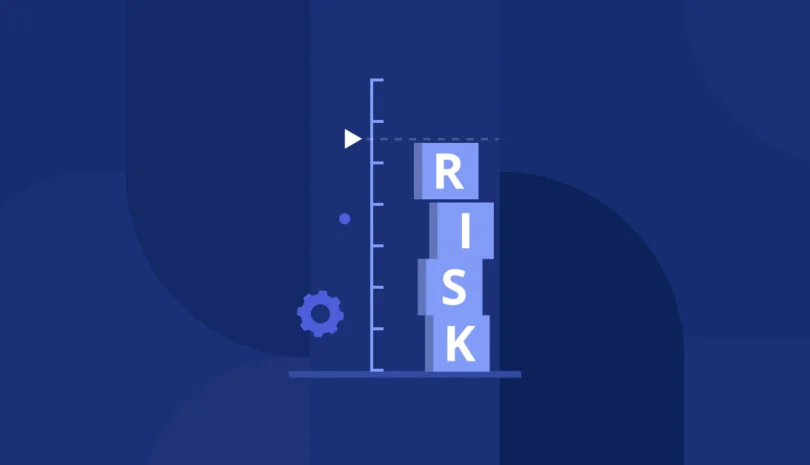As vendor ecosystems grow more complex, audits have become a critical checkpoint for trust, compliance, and risk management. As vendor ecosystems grow more complex, audits have become a critical checkpoint for trust, compliance, and risk management. According to Verizon’s 2025 Data Breach Investigations Report, third-party involvement in breaches doubled to 30%, highlighting the increasing risks tied to external vendors When a vendor fails an audit, it’s not just their issue; it’s your liability.
A failed vendor audit can trigger a cascade of consequences: regulatory exposure, service disruptions, reputational damage, and financial fallout. And if the vendor plays a critical role in your operations or handles sensitive data, the impact can be even more severe.
In this post, we’ll break down the most common reasons vendors fail audits, from outdated documentation to weak access controls, and what those failures mean for your business. You’ll also learn how to prepare your vendor ecosystem for audits proactively, respond when a failure happens, and strengthen your third-party risk management (TPRM) program overall.
Because in vendor risk, surprises are costly, and audit readiness is your first line of defense.
Incomplete or Outdated Security Documentation Can Cause Vendors to Fail Audits
One of the most common reasons vendors fail audits is incomplete or outdated security documentation. Auditors expect to see clearly defined and current policies that demonstrate a vendor’s commitment to security and compliance. When key documents, such as incident response plans, data retention policies, or business continuity procedures, are missing, it signals potential gaps in the vendor’s security posture.
Equally important is evidence of implementation. It’s not enough to have policies written; vendors must show proof that controls are in place and actively maintained. This includes audit logs, control testing results, or records of security training.
For your organization, partnering with vendors that lack documentation can increase regulatory exposure and undermine risk management efforts. Regular documentation reviews and vendor assessments can help you catch these issues before they escalate into audit failures.
Inadequate Access Controls or Privilege Management Lead to Vendor Audit Failures
Vendors often fail audits due to weak access controls or poor privilege management. Common red flags include over-permissioned users, shared accounts, and the absence of role-based access controls (RBAC). These issues increase the likelihood of unauthorized access to sensitive systems or data, something auditors take seriously.
In some cases, vendors may lack basic safeguards like multi-factor authentication (MFA) or fail to enforce strong password policies. Without proper authentication protocols in place, even well-meaning employees can become security liabilities.
Access-related findings during an audit can indicate deeper issues with identity governance and access hygiene. For organizations that rely on these vendors, it opens the door to data breaches, compliance violations, and operational risk.
That’s why evaluating vendors for access control maturity should be a priority during onboarding and monitored regularly throughout the relationship.
Noncompliance with Regulatory Frameworks
A vendor’s failure to meet regulatory requirements is a major reason for audit failure and a serious risk to your organization. Depending on your industry and geography, frameworks like HIPAA, PCI-DSS, GDPR, and DORA may apply. If a vendor handles regulated data but can’t demonstrate compliance, it could expose your business to fines, legal action, or loss of certification.
Auditors often look for documented evidence of compliance, including security policies, data handling procedures, and certifications. A frequent gap is the lack of a clear data processing agreement (DPA) that outlines how vendor partners collect, store, and secure personal or sensitive information.
Without these foundational documents in place, auditors may flag the vendor as noncompliant, putting your company’s own compliance posture at risk. That’s why regulatory alignment should be a key factor in third-party selection and due diligence.
Poor Risk Assessment or Monitoring Practices Lead to Vendor Audit Failures
Audits don’t just evaluate a vendor’s current security posture; they also assess how well vendors manage risk over time. One common cause of audit failure is relying solely on static, point-in-time assessments. Without continuous monitoring or periodic reassessments, vendors may miss emerging threats, control failures, or changes in business-critical dependencies.
Another frequent issue is the inability to demonstrate due diligence across the supply chain. If a vendor can’t show how they evaluate and monitor their own third or fourth parties, auditors may question the overall integrity of the vendor’s risk management program.
Strong vendors regularly reassess their risks, update controls, and maintain documentation that shows proactive oversight. Without these practices, vendors may be seen as reactive, or worse, negligent, which can reflect poorly on the organizations they serve.
Gaps in Business Continuity or Incident Response Plans
Business continuity and incident response plans are key components of vendor audit readiness. Yet many vendors lack formal, tested recovery procedures, or worse, they have plans on paper that haven’t been validated through real-world scenarios or tabletop exercises.
Auditors expect vendors to be prepared for disruptions, whether caused by cyber incidents, outages, or natural disasters. If there’s no evidence of a tested recovery plan or a clear breach notification process, that vendor may be flagged as a liability.
Equally important is the ability to notify clients promptly in the event of a breach. Without defined communication protocols, your organization could be left in the dark during a critical incident, delaying response efforts and increasing potential damage.
Identifying these gaps early through assessments and ongoing monitoring helps ensure your vendors can recover quickly and responsibly when issues arise.
What a Failed Vendor Audit Means for Your Business
A failed vendor audit isn’t just an internal issue for the vendor; it can quickly become a critical risk for your organization. If that vendor plays a key role in your operations or handles sensitive data, the consequences can extend across security, compliance, and business continuity.
From legal exposure to lost customer trust, the impact is often broader and more costly than teams expect. The following sections break down four key areas where a vendor’s audit failure can directly affect your organization: regulatory exposure, operational disruption, reputational risk, and financial impact.
Regulatory Exposure
When a vendor fails an audit, your organization may face regulatory consequences due to shared accountability. Under frameworks like GDPR, the SEC’s cyber disclosure rules, or NIS2, responsibility doesn’t stop at your firewall. If a third party mishandles data or violates compliance obligations, your business could be on the hook for fines, reporting violations, or additional oversight. A failed audit may also trigger scrutiny of your own compliance program. Even if your controls are sound, regulators and auditors expect you to evaluate vendors with the same rigor, making vendor oversight a legal and operational requirement, not just a best practice.
Operational Disruption
Audit failures often reveal control gaps that can lead to operational problems. If a vendor supports critical business functions, any fallout, whether a suspension, service degradation, or remediation effort, can slow down your operations. In cases where no contingency or failover plan is in place, your organization may be left scrambling to maintain continuity. Failed audits can also introduce uncertainty into vendor relationships, leading to paused projects or additional delays. This disruption doesn’t just affect internal workflows; it can ripple out to customers, partners, and other vendors, putting broader business performance at risk.
Reputational Risk
If a vendor that fails an audit is customer-facing or processes sensitive data, your brand may absorb the reputational damage. Headlines don’t distinguish between your company and your third party; they just highlight the failure. Even if the root cause lies with the vendor, clients, partners, and regulators may question your ability to assess and manage third-party risk. A high-profile audit failure can undermine stakeholder confidence and raise doubts about your entire TPRM program. Rebuilding trust takes time, and in some industries, a hit to your credibility can have long-term consequences.
Financial Impact
The financial fallout from a failed vendor audit can escalate quickly. You may face higher cyber insurance premiums, spend more on incident remediation, or incur penalties for breach of contract. Some vendors may be forced to halt services, triggering contract renegotiations or even termination. In critical cases, you may need to switch vendors altogether, an expensive and time-consuming process that also carries its risks. On top of these direct costs, there are indirect ones: time lost to audits, legal review, and internal stakeholder alignment. These financial pressures compound the broader business impact of third-party failures.
How to Prevent and Prepare for Vendor Audit Failures
Vendor audit failures are often preventable, but only with the right structure in place. A reactive approach puts your organization at risk, while proactive preparation strengthens resilience across your entire third-party ecosystem.
Building audit-readiness into your vendor management lifecycle helps reduce surprises, minimize exposure, and improve overall vendor performance. It’s not just about setting high standards, it’s about helping vendors meet them.
The following four strategies can help your organization prevent audit failures before they happen: integrating audit requirements into onboarding, performing continuous risk reviews, providing vendor support, and establishing a clear contingency plan.
Build Audit-Readiness into Vendor Selection and Onboarding
Preventing audit failures starts before the contract is signed. During procurement, include audit and compliance expectations directly in vendor agreements. Require vendors to agree to regular assessments, data security obligations, and documentation standards. Early-stage baseline assessments can also reveal potential red flags, such as missing certifications or unclear data handling practices, before the relationship becomes critical. When vendors understand that audit-readiness is a prerequisite from day one, they’re more likely to invest in the processes and documentation needed to meet expectations later. It sets the tone for accountability while reducing the chance of surprises during formal audits.
Conduct Proactive Risk Reviews and Continuous Monitoring
Relying solely on annual assessments isn’t enough. Risk changes over time, and so should your visibility. Use tools like external scanning, TPRM platforms, and automated alerts to monitor vendor environments continuously. These tools help surface vulnerabilities, expired certificates, data exposure events, and other early indicators of risk. Consider building a tiered vendor risk model that allocates more frequent reviews and deeper scrutiny to high-impact or high-risk vendors. By keeping an active pulse on your third-party ecosystem, you can catch problems before they escalate to audit-level failures and take corrective action in real time.
Offer Vendor Support and Resources
Sometimes vendors fail audits not because of negligence, but because they lack guidance. Offering support can raise the baseline across your vendor ecosystem. Share audit preparation checklists, security questionnaire templates, or compliance guidelines to help vendors understand what’s expected. Hosting webinars or offering office hours for onboarding support, security questions, or documentation guidance can go a long way in improving outcomes. This collaborative approach strengthens vendor relationships while increasing the likelihood of successful audits. It also signals that your organization is invested in mutual success, not just top-down enforcement.
Establish a Contingency Plan
Even with preparation, audit failures can happen, and when they do, your response matters. Create a contingency plan that outlines steps to take if a critical vendor fails an audit. This includes defining exit strategies, identifying backup vendors, and establishing criteria for reassessing or remediating the relationship. Document vendor-specific incident response playbooks to ensure internal teams know how to act quickly in high-stakes scenarios. Planning ahead reduces downtime, protects continuity, and helps your team make clear, confident decisions when under pressure.
What to Do if a Critical Vendor Fails an Audit
When a critical vendor fails an audit, your immediate priority is understanding the scope of the risk. Start by assessing the business impact: What systems or data are affected? Is the vendor still compliant with contractual and regulatory obligations? Engage relevant teams, security, legal, procurement, and business owners, to evaluate dependencies and determine next steps.
Clear communication is essential. Inform internal stakeholders early, especially those whose operations rely on the vendor. Transparency helps align response efforts and prevents misinformation from slowing down decision-making.
Next, work with the vendor to establish a remediation timeline. What controls need to be addressed, and how quickly can they be resolved? In some cases, enhanced monitoring or a temporary usage restriction may be warranted. For higher-risk scenarios, initiate your contingency plan: activate a backup provider or begin replacement procedures.
Not all audit failures require termination, but all require accountability. Document findings, actions taken, and decisions made to ensure a defensible, repeatable process moving forward.
Why Vendors Fail Audits: Being Proactive, Not Reactive
Vendor audit failures aren’t just isolated compliance issues; they can compromise your business’s operational resilience, regulatory standing, and brand reputation. From outdated documentation to poor access controls, each failure point increases your exposure and makes recovery more complex.
The key is not to wait for audits to surface problems. Proactive vendor governance, rooted in continuous monitoring, clear expectations, and strong onboarding, helps identify and address risks before they become liabilities. Rather than scrambling to react, organizations should build systems that prevent audit failures in the first place.
Panorays helps you stay ahead by giving you complete visibility into third-party security posture. Our platform automates vendor assessments, monitors for emerging threats, and flags compliance gaps across your vendor ecosystem. Whether you’re onboarding a new partner or evaluating an existing one, Panorays aligns your audit-readiness process with real-world business risk.
Vendor audits shouldn’t be a scramble; they should be a confirmation of what you already know. Book a personalized demo to see how Panorays can help you reduce audit failures and strengthen third-party governance at scale.
Vendor Audit Failure FAQs
-
Yes. A failed audit can expose your organization to regulatory penalties, operational disruptions, reputational harm, and even contractual breaches, especially if the vendor handles sensitive data or supports critical operations. Regulators may hold your organization accountable if proper vendor oversight wasn’t in place.
-
Start by integrating audit-readiness into vendor selection, onboarding, and contract terms. Conduct regular risk assessments, offer clear compliance guidance, and use tools like Panorays to continuously monitor third-party security posture. Preventive governance is more effective and less costly than reactive remediation.
-
An effective checklist should cover documentation of security policies, access controls, regulatory compliance (GDPR, HIPAA), data processing agreements (DPAs), incident response plans, business continuity testing, and evidence of control implementation. Tailor the checklist to vendor risk tier and business criticality.
-
Sometimes. It depends on the severity of the findings and your organization’s risk tolerance. In many cases, vendors can be remediated with a corrective action plan, enhanced monitoring, or temporary restrictions. High-risk vendors may require replacement or service suspension.



